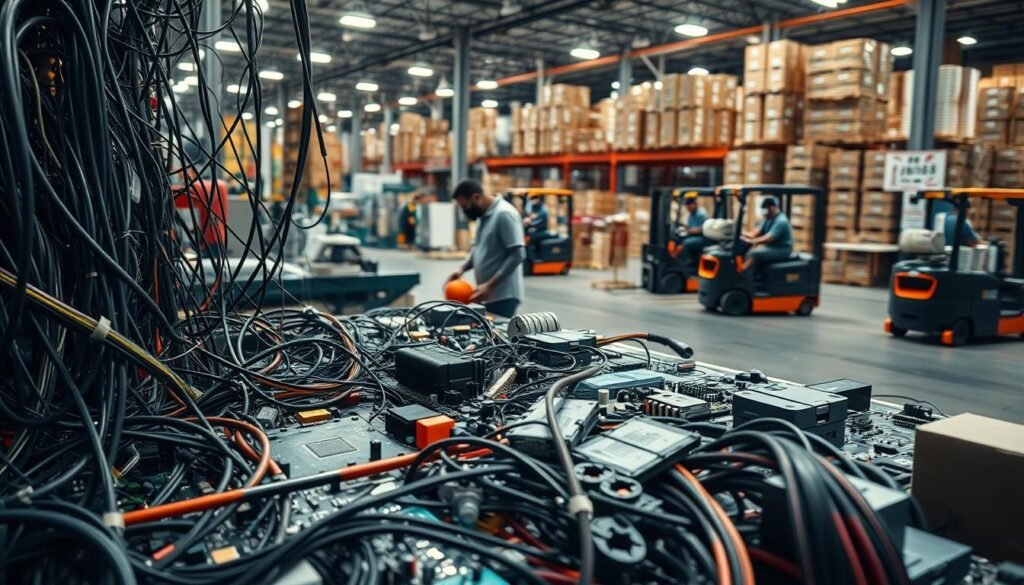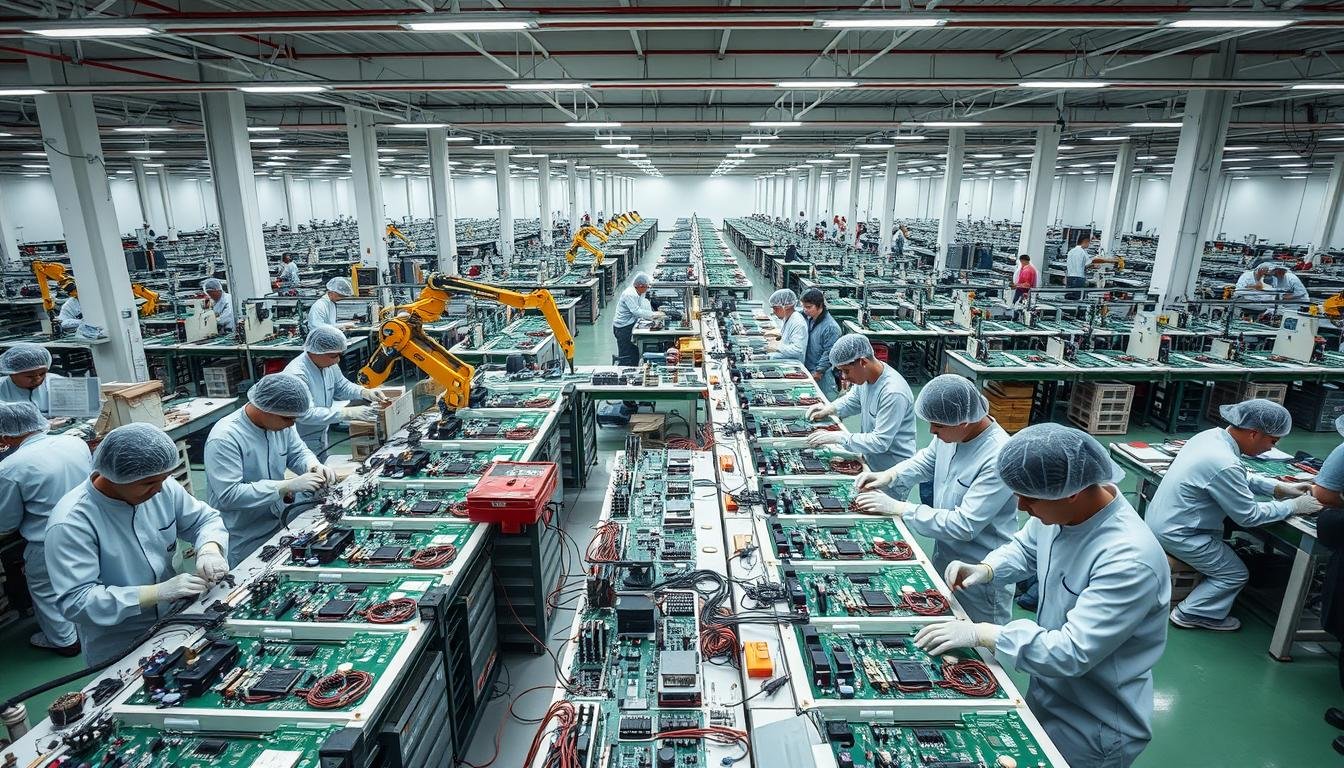Imagine navigating today’s electronics landscape where 52% of printed circuit boards originate from one country. Recent tariffs on multi-layer PCB imports now exceed 170%, yet manufacturers still rely heavily on Asian partners. Why hasn’t this shifted production closer to home?
We’ve entered an era where supply chain resilience clashes with economic realities. Domestic U.S. fabrication facilities face 3-5 day quote delays, while alternative regions charge 20% premiums. Even with trade barriers, China’s technical infrastructure remains unmatched for complex designs.
The truth? Switching suppliers risks disrupting years of collaborative engineering and quality validation. Meanwhile, tariff policies fluctuate weekly, leaving procurement teams in limbo. This isn’t just about cost—it’s about maintaining innovation velocity in a hypercompetitive market.
Key Takeaways
- China controls over half the global PCB market despite rising import duties
- U.S. fabrication capacity struggles with extended lead times and selective project acceptance
- Alternative manufacturing hubs face pricing and efficiency challenges compared to China
- Tariff uncertainty forces companies to balance cost risks against supply chain stability
- Established supplier relationships remain critical for technical consistency
Overview of the China PCB Supply Chain
Modern electronics rely on a tightly choreographed dance between raw materials and precision engineering. At its core lies a two-phase production process that transforms copper-clad laminates into functional components powering everything from smartphones to satellites.
Understanding PCB Fabrication and Assembly
Fabrication begins with layering dielectric materials and conductive copper sheets. Advanced etching techniques create intricate circuit patterns, while surface finishes like ENIG (Electroless Nickel Immersion Gold) ensure durability. This stage produces the bare boards that form a product’s nervous system.
Assembly brings these boards to life. Automated systems apply solder paste with micron-level accuracy before placing components at speeds exceeding 30,000 parts per hour. One industry expert notes:
“Chinese facilities now achieve first-pass yields rivaling Western counterparts, often exceeding 98.5%.”
The Role of China in Global PCB Manufacturing
Three factors cemented China’s dominance:
- Government-backed industrial parks clustering suppliers within 50-mile radii
- Continuous reinvestment in surface mount technology and 3D AOI (Automated Optical Inspection)
- Vertical integration from raw copper foil to finished assemblies
This ecosystem enables rapid scaling unmatched elsewhere. While labor costs rise, investments in AI-driven quality control maintain competitive margins. Over 60% of multilayer boards for 5G infrastructure now originate from Chinese factories using proprietary stacking techniques.
Navigating Tariff Changes and Regulatory Challenges

Global trade dynamics are reshaping electronics procurement strategies. April 2024 saw unprecedented volatility, with duty rates shifting daily across PCB categories. Importers now face a complex matrix of compliance requirements that directly impact bottom-line profitability.
Impact of Tariffs on PCB Costs and Lead Times
Current duty structures create stark contrasts in price calculations:
| PCB Layers | Duty Rate | Cost Impact |
|---|---|---|
| 2-4 Layer Rigid | 145% | $14,500 per $10k order |
| 6+ Layer/Complex | 170% | $17,000 per $10k order |
One procurement manager shared:
“We received three shipments in April with three different duty rates. Our team now spends 40% more time verifying customs documentation than last quarter.”
Ensuring Compliance for U.S. Importers
Four critical strategies help mitigate regulatory risks:
- Verify EXW pricing excludes freight/overhead
- Cross-reference HS codes against Section 301 lists
- Require suppliers to provide material breakdowns
- Audit freight bills for hidden duty triggers
These changes have transformed traditional roles. Sales teams now function as compliance specialists, reviewing invoices line-by-line. Proper classification prevents unexpected cost increases that can erase thin margins in competitive markets.
Forward-thinking businesses are adapting through specialized trade partnerships. Licensed customs brokers provide real-time updates on rate fluctuations, while automated tracking systems flag classification discrepancies before shipments depart.
Logistics and Shipping of PCBAs from China: What to Expect

Annual production cycles create predictable yet disruptive patterns in electronics manufacturing. The Chinese New Year (CNY) shutdown remains the most critical period, with factory closures lasting 15-30 days. Over 40 million workers traveling home create transportation gridlock that impacts component deliveries for weeks.
Managing Freight, Duty Rates, and Invoices
Pre-CNY capacity crunches require proactive strategies. Container ships and air freight hit 92% occupancy rates in Q4 as companies rush orders. One logistics manager explains:
“We now place Christmas orders by August to secure vessel space. Buffer inventory prevents assembly line stoppages when factories reopen slowly.”
Weight restrictions add complexity. North American road limits (44,000 lbs) clash with Chinese loading practices. A standard 40-foot container often exceeds local limits by 15%, forcing costly unloading or fines.
| Container Type | China Load | US Limit |
|---|---|---|
| 40ft Dry | 50,700 lbs | 44,000 lbs |
| 40ft High Cube | 52,900 lbs | 44,000 lbs |
Evaluating Long-Term Supplier Relationships
Established partnerships prove invaluable during crises. Suppliers prioritizing loyal clients during CNY shortages can mean the difference between meeting deadlines and production delays. Switching vendors risks:
- Loss of volume discounts
- Extended quality validation cycles
- Increased engineering support needs
Smart companies negotiate through bills of lading for inland distribution. This approach cuts handling by 40% compared to traditional port transfers. While tariffs fluctuate, trusted supplier networks provide stability in turbulent markets.
Leveraging Technological Advances in PCB Manufacturing
Precision meets innovation as modern circuit board production enters its next evolutionary phase. Cutting-edge facilities now combine AI-driven automation with sustainability-focused processes, redefining what’s possible in electronics development. This transformation addresses both technical demands and environmental responsibilities.
Revolutionizing Assembly Through Automation
Leading Chinese manufacturers deploy surface mount technology capable of placing 01005 components (0.4mm x 0.2mm) at 150,000 placements per hour. One factory manager explains:
“Our vision systems detect solder paste defects smaller than 15 microns – thinner than human hair. This precision enables first-pass yields exceeding 99.2%.”
These systems integrate with 5G infrastructure production, handling complex multi-layer designs essential for next-gen devices.
Mastering Miniaturization Challenges
The push for compact electronics demands PCBs with 0.2mm via holes and 3mil trace widths. Manufacturers achieve this through:
- Laser-direct imaging for ultra-fine circuitry
- Modified solder mask formulations preventing bridging
- X-ray inspection verifying hidden connections
Simultaneously, eco-friendly materials replace traditional substrates. Halogen-free laminates now constitute 38% of production lines, balancing performance with regulatory compliance.
These advancements enable design teams to create smaller, smarter products without sacrificing reliability. From medical implants to satellite components, the marriage of technical prowess and environmental stewardship reshapes global electronics manufacturing.
Building a Resilient Supply Chain Strategy
Global production networks require adaptive solutions to maintain operational continuity. We’ve identified three pillars for creating robust systems that withstand market volatility while protecting profit margins.
Smart Inventory Management
Seasonal demand spikes and factory shutdowns demand precise planning. Successful teams:
- Maintain 12-week buffer stock before Chinese New Year
- Combine air/sea freight for urgent orders
- Use predictive analytics to adjust reorder points
One procurement director shared:
“Our hybrid shipping approach cut emergency air freight costs by 62% last quarter.”
Evaluating Partnership Value
Switching suppliers often costs 3-5x tooling expenses. Established relationships provide:
- Priority production slots during shortages
- Shared process improvements
- Volume-based pricing advantages
We recommend parallel testing new vendors while maintaining existing chains for critical components.
Strategic Commercial Terms
Incoterms selection directly impacts landed costs. Consider:
| Term | Risk Transfer | Cost Control |
|---|---|---|
| EXW | Buyer | High |
| DDP | Seller | Low |
Partnering with certified brokers ensures proper classification and duty optimization. Their expertise often recovers 5-7% in hidden tariff savings through HS code adjustments.
Conclusion
Strategic balance defines success in global electronics production. While tariff pressures intensify, Chinese partners remain critical for PCB assembly excellence. As industry veteran Hayao Nakahara observes: “Without capacity, there is no growth” – a reality facing firms seeking alternatives to established manufacturing ecosystems.
Effective solutions require dual focus. Maintaining supply chain resilience means investing in compliance teams while preserving hard-won supplier relationships. Contingency plans must account for China’s unmatched production scale – over 60% of multilayer boards originate here.
Three priorities emerge for sustainable operations:
1. Partner with logistics experts navigating complex trade regulations
2. Validate alternative suppliers without disrupting existing quality benchmarks
3. Allocate resources for real-time market adaptation
The path forward rewards businesses prioritizing technical capability over short-term cost cuts. By leveraging proven manufacturing networks and emerging technologies, companies can meet rising demand while delivering reliable circuit boards for next-gen products.
FAQ
How do tariffs affect total landed costs for PCB assemblies?
What quality certifications should reliable PCB suppliers hold?
Can surface mount technology handle high-density interconnect designs?
What incoterms optimize logistics partnerships for PCB shipments?
How does dual sourcing reduce supply chain disruptions?
What documentation ensures smooth customs clearance?
How are PCB manufacturers addressing material shortages?
What turnaround times are realistic for complex multilayer boards?
About The Author
Elena Tang
Hi, I’m Elena Tang, founder of ESPCBA. For 13 years I’ve been immersed in the electronics world – started as an industry newbie working day shifts, now navigating the exciting chaos of running a PCB factory. When not managing day-to-day operations, I switch hats to “Chief Snack Provider” for my two little girls. Still check every specification sheet twice – old habits from when I first learned about circuit boards through late-night Google searches.
